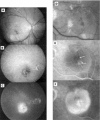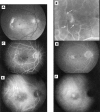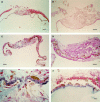Clinicopathological correlation of deep retinal vascular anomalous complex in age related macular degeneration
- PMID: 11049953
- PMCID: PMC1723325
- DOI: 10.1136/bjo.84.11.1269
Clinicopathological correlation of deep retinal vascular anomalous complex in age related macular degeneration
Abstract
Aims: To analyse the histopathology of "deep retinal vascular anomalous complex" or "chorioretinal anastomosis".
Methods: Six patients with a deep retinal vascular anomalous complex (age range 66-88 years) had fundus photography and fluorescein angiography not more than 14 days before foveal translocation surgery. Four patients were also documented with indocyanine green angiography. The surgical specimens were serially sectioned and stained in a stepped fashion with Masson trichrome, periodic acid Schiff, and phosphotungstic acid haematoxylin, a histochemical stain for fibrin.
Results: A subretinal fibrovascular membrane was surrounded by a rim consisting of diffuse drusen (basal laminar deposits), retinal pigment epithelium, and amorphous, fibrinous material interspersed with remains of outer segments in all specimens. In two specimens vascular structures were identified that left the specimen towards the retina. Amorphous material with the remains of outer segments was not found on the retinal side of the fibrovascular tissue itself but in four specimens a small neuroretinal portion (outer nuclear layer) was adherent to the complex. In three specimens a thin fibrocellular membrane was seen at the choroidal side of the diffuse drusen.
Conclusion: Deep retinal vascular anomalous complex represents histologically neovascularisation growing out of the neuroretina, into the subretinal space, which mimics choroidal neovascularisation. The term therefore appears rightly chosen.
Figures



References
MeSH terms
LinkOut - more resources
Full Text Sources
Medical
